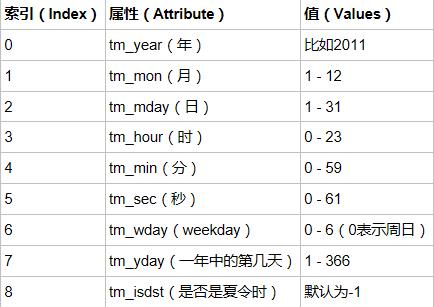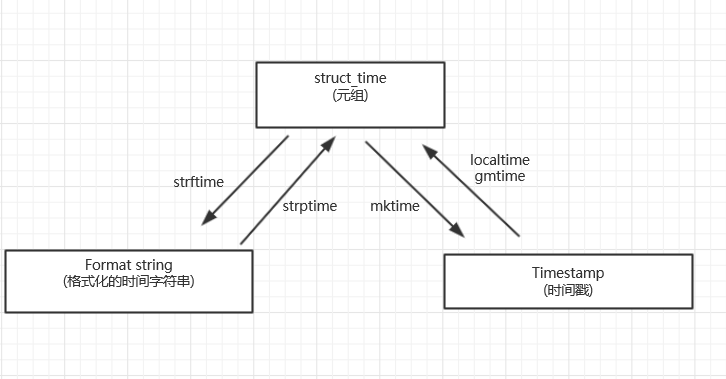今日内容:
1.时间模块 (time)
2.随机数 (random)
3.sys模块
4.os模块
5.序列化模块
1.时间模块(time)
表示时间的三种方式:
1.时间戳(timestamp)
2.格式化的时间字符串(Format String)
3.元组(结构化) (struct time)
1.时间戳:
time.sleep() #使程序滞留一段时间,该时间以 秒 为单位。 time.time() #时间戳, 即 记录某个时间点
2.格式化时间字符串的各种参数用法:如下

%y 两位数的年份表示(00-99) %Y 四位数的年份表示(000-9999) %m 月份(01-12) %d 月内中的一天(0-31) %H 24小时制小时数(0-23) %I 12小时制小时数(01-12) %M 分钟数(00=59) %S 秒(00-59) %a 本地简化星期名称 %A 本地完整星期名称 %b 本地简化的月份名称 %B 本地完整的月份名称 %c 本地相应的日期表示和时间表示 %j 年内的一天(001-366) %p 本地A.M.或P.M.的等价符 %U 一年中的星期数(00-53)星期天为星期的开始 %w 星期(0-6),星期天为星期的开始 %W 一年中的星期数(00-53)星期一为星期的开始 %x 本地相应的日期表示 %X 本地相应的时间表示 %Z 当前时区的名称 %% %号本身 print(time.strftime('%Y.%m.%d %X')) print(time.strftime('%Y.%m.%d %x')) print(time.strftime('%y%m%d %H%M%S ')) print(time.strftime('%y%m%d %I%M%S %a')) print(time.strftime('%y%m%d %I%M%S %A')) print(time.strftime('%y%m%d %I%M%S %A %b')) print(time.strftime('%y%m%d %I%M%S %A %B')) print(time.strftime('%y%m%d %I%M%S %A %B %c')) print(time.strftime('%y%m%d %I%M%S %A %B %c %j')) print(time.strftime('%y%m%d %I%M%S %A %B %c %j %p')) print(time.strftime('%y%m%d %I%M%S %A %B %c %j %p %U')) print(time.strftime('%y%m%d %I%M%S %A %B %c %j %p %U %w')) print(time.strftime('%y%m%d %I%M%S %A %B %c %j %p %U %W')) print(time.strftime('%y%m%d %I%M%S %A %B %c %j %p %U %W %Z')) 结果: 2017.08.08 18:51:58 2017.08.08 08/08/17 170808 185158 170808 065158 Tue 170808 065158 Tuesday 170808 065158 Tuesday Aug 170808 065158 Tuesday August 170808 065158 Tuesday August Tue Aug 8 18:51:58 2017 170808 065158 Tuesday August Tue Aug 8 18:51:58 2017 220 170808 065158 Tuesday August Tue Aug 8 18:51:58 2017 220 PM 170808 065158 Tuesday August Tue Aug 8 18:51:58 2017 220 PM 32 170808 065158 Tuesday August Tue Aug 8 18:51:58 2017 220 PM 32 2 170808 065158 Tuesday August Tue Aug 8 18:51:58 2017 220 PM 32 32 170808 065158 Tuesday August Tue Aug 8 18:51:58 2017 220 PM 32 32 ?D1¨²¡À¨º¡Á?¨º¡À??
3.元组(结构化):struct_time元组共有9个元素共九个元素:(年,月,日,时,分,秒,一年中第几周,一年中第几天等)

m = time.localtime() #类似命名元组 用于计算比对。 print(m) print(m.tm_year)
结果:
time.struct_time(tm_year=2017, tm_mon=8, tm_mday=8, tm_hour=18, tm_min=54, tm_sec=21, tm_wday=1, tm_yday=220, tm_isdst=0) 2017 Process finished with exit code 0
小结:时间戳是计算机能够识别的时间;时间字符串是人能够看懂的时间;元组则是用来操作时间的
三种格式之间的转换:
1.时间戳(timestamp)
2.格式化的时间字符串(Format String)
3.元组(结构化) (struct time)


#时间戳 转 结构化 和 结构化 转 时间戳 print(time.gmtime()) #伦敦时间 print(time.localtime()) #北京时间 s = time.gmtime(1500000000) #时间戳 转 结构化 d = time.localtime(1500000000) #时间戳 转 结构化 print(s) print(d) print(time.mktime(s)) #结构化 转 时间戳 print(time.mktime(d)) #结构化 转 时间戳 结果: time.struct_time(tm_year=2017, tm_mon=8, tm_mday=8, tm_hour=11, tm_min=26, tm_sec=54, tm_wday=1, tm_yday=220, tm_isdst=0) time.struct_time(tm_year=2017, tm_mon=8, tm_mday=8, tm_hour=19, tm_min=26, tm_sec=54, tm_wday=1, tm_yday=220, tm_isdst=0) time.struct_time(tm_year=2017, tm_mon=7, tm_mday=14, tm_hour=2, tm_min=40, tm_sec=0, tm_wday=4, tm_yday=195, tm_isdst=0) time.struct_time(tm_year=2017, tm_mon=7, tm_mday=14, tm_hour=10, tm_min=40, tm_sec=0, tm_wday=4, tm_yday=195, tm_isdst=0) 1499971200.0 1500000000.0 Process finished with exit code 0 #结构化 转 字符串 和 字符串 转 结构化 print(time.strftime('%Y%m%d %X')) #结构化转 字符串 print(time.strptime('2017-03-16','%Y-%m-%d')) #字符串 转 结构化 结果: 20170808 19:29:32 time.struct_time(tm_year=2017, tm_mon=3, tm_mday=16, tm_hour=0, tm_min=0, tm_sec=0, tm_wday=3, tm_yday=75, tm_isdst=-1) Process finished with exit code 0
2.随机数(random)模块:
import random #随机小数 print(random.random()) #大于0且小于1的小数。 print(random.uniform(1,3)) #大于1小于3的小数 #随机整数 print(random.randint(1,5)) #随机1-5的之间的整数。顾头顾尾 print(random.randrange(10)) print(random.randrange(1,10,2)) #随机选择一个返回 print(random.choice([1,2,3,4,[11,111,1111],'zxc'])) #随机选择多个返回,返回的个数为函数的第二个参数 print(random.sample([1,2,3,4,[5,6,7,8]],2)) #任意返回多个值,后面参数2 是用户之间定义的。 #打乱列表顺序 item = [1,3,5,7,9] print(item) random.shuffle(item) print(item) 结果: 0.8872507582462091 1.3964555681725257 1 3 7 4 [[5, 6, 7, 8], 4] [1, 3, 5, 7, 9] [7, 1, 3, 9, 5] Process finished with exit code 0
1.写一个验证码 1.要有数字, 2,要有字母 3,一共四位 4 可以重复
拿字母,用acsii 码, 拿到后,就转换成字符串。 65-90 97-122。

第一种方法: def v_code (): code = '' '' for i in range (4): num = random.randint(0,9) alf = chr(random.randint(65,90)) alp = chr(random.randint(97,122)) add = random.choice([num,alf,alp]) code = ''.join([code,str(add)]) return code print(v_code()) 第二种方法: list1 = list (range(10)) new_list = list(map(str,list1)) alf = list(range(65,91)) alp = list(range(95,123)) alf_l=[] for i in range (65,91): alf = chr(i) alf_l.append(alf) alp_l=[] for i in range (95,123): alp = chr(i) alp_l.append(alp) new_list.extend(alf_l) new_list.extend(alp_l) ret = [] ret = random.sample(new_list,4) print(''.join(ret))
3.OS模块
'''
os.getcwd() 获取当前工作目录,即当前python脚本工作的目录路径
os.chdir("dirname") 改变当前脚本工作目录;相当于shell下cd
os.curdir 返回当前目录: ('.')
os.pardir 获取当前目录的父目录字符串名:('..')
os.makedirs('dirname1/dirname2') 可生成多层递归目录
os.removedirs('dirname1') 若目录为空,则删除,并递归到上一级目录,如若也为空,则删除,依此类推
os.mkdir('dirname') 生成单级目录;相当于shell中mkdir dirname
os.rmdir('dirname') 删除单级空目录,若目录不为空则无法删除,报错;相当于shell中rmdir dirname
os.listdir('dirname') 列出指定目录下的所有文件和子目录,包括隐藏文件,并以列表方式打印
os.remove() 删除一个文件
os.rename("oldname","newname") 重命名文件/目录
os.stat('path/filename') 获取文件/目录信息
os.sep 输出操作系统特定的路径分隔符,win下为"\",Linux下为"/"
os.linesep 输出当前平台使用的行终止符,win下为"
",Linux下为"
"
os.pathsep 输出用于分割文件路径的字符串 win下为;,Linux下为:
os.name 输出字符串指示当前使用平台。win->'nt'; Linux->'posix'
os.system("bash command") 运行shell命令,直接显示
os.popen("bash command) 运行shell命令,获取执行结果
os.environ 获取系统环境变量
os.path
os.path.abspath(path) 返回path规范化的绝对路径 os.path.split(path) 将path分割成目录和文件名二元组返回 os.path.dirname(path) 返回path的目录。其实就是os.path.split(path)的第一个元素 os.path.basename(path) 返回path最后的文件名。如何path以/或结尾,那么就会返回空值。
即os.path.split(path)的第二个元素
os.path.exists(path) 如果path存在,返回True;如果path不存在,返回False
os.path.isabs(path) 如果path是绝对路径,返回True
os.path.isfile(path) 如果path是一个存在的文件,返回True。否则返回False
os.path.isdir(path) 如果path是一个存在的目录,则返回True。否则返回False
os.path.join(path1[, path2[, ...]]) 将多个路径组合后返回,第一个绝对路径之前的参数将被忽略
os.path.getatime(path) 返回path所指向的文件或者目录的最后访问时间
os.path.getmtime(path) 返回path所指向的文件或者目录的最后修改时间
os.path.getsize(path) 返回path的大小
'''
4.sys模块:
sys模块是与python解释器交互的一个接口
sys.argv 命令行参数List,第一个元素是程序本身路径 sys.exit(n) 退出程序,正常退出时exit(0) sys.version 获取Python解释程序的版本信息 sys.maxint 最大的Int值 sys.path 返回模块的搜索路径,初始化时使用PYTHONPATH环境变量的值 sys.platform 返回操作系统平台名称
5.序列化模块:
什么叫序列化——将原本的字典、列表等内容转换成一个字符串的过程就叫做序列化。
序列化的目的

json:
Json模块提供了四个功能:dumps、dump、loads、load

import json d = {'k':1} ret1= json.dumps(d) #字典转字符串 print(ret1,type(ret1)) ret2= json.loads(ret1) #字符串转字典 print(ret2,type(ret2)) f = open('json_file','w') dic = {'k1':'v1','k2':'v2','k3':'v3'} json.dump(dic,f) #dump方法接收一个文件句柄,直接将字典转换成json字符串写入文件 f.close() print(dic) f = open('json_file') dic2 = json.load(f) #load方法接收一个文件句柄,直接将文件中的json字符串转换成数据结构返回 f.close() print(type(dic2),dic2) 结果: {"k": 1} <class 'str'> {'k': 1} <class 'dict'> {'k1': 'v1', 'k2': 'v2', 'k3': 'v3'} <class 'dict'> {'k1': 'v1', 'k2': 'v2', 'k3': 'v3'} Process finished with exit code 0
pickle:
用于序列化的两个模块
- json,用于字符串 和 python数据类型间进行转换
- pickle,用于python特有的类型 和 python的数据类型间进行转换
pickle模块提供了四个功能:dumps、dump(序列化,存)、loads(反序列化,读)、load (不仅可以序列化字典,列表...可以把python中任意的数据类型序列化)
这里我们要说明一下,json是一种所有的语言都可以识别的数据结构。
如果我们将一个字典或者序列化成了一个json存在文件里,那么java代码或者js代码也可以拿来用。
但是如果我们用pickle进行序列化,其他语言就不能读懂这是什么了~
所以,如果你序列化的内容是列表或者字典,我们非常推荐你使用json模块
但如果出于某种原因你不得不序列化其他的数据类型,而未来你还会用python对这个数据进行反序列化的话,那么就可以使用pickle
shelve:
shelve也是python提供给我们的序列化工具,比pickle用起来更简单一些。
shelve只提供给我们一个open方法,是用key来访问的,使用起来和字典类似。

import shelve f = shelve.open('shelve_file') f['key'] = {'int':10, 'float':9.5, 'string':'Sample data'} #直接对文件句柄操作,就可以存入数据 f.close() import shelve f1 = shelve.open('shelve_file') existing = f1['key'] #取出数据的时候也只需要直接用key获取即可,但是如果key不存在会报错 f1.close() print(existing)
这个模块有个限制,它不支持多个应用同一时间往同一个DB进行写操作。所以当我们知道我们的应用如果只进行读操作,我们可以让shelve通过只读方式打开DB

import shelve f = shelve.open('shelve_file', flag='r') existing = f['key'] f.close() print(existing)
由于shelve在默认情况下是不会记录待持久化对象的任何修改的,所以我们在shelve.open()时候需要修改默认参数,否则对象的修改不会保存。

import shelve f1 = shelve.open('shelve_file') print(f1['key']) f1['key']['new_value'] = 'this was not here before' f1.close() f2 = shelve.open('shelve_file', writeback=True) print(f2['key']) f2['key']['new_value'] = 'this was not here before' f2.close()
writeback方式有优点也有缺点。优点是减少了我们出错的概率,并且让对象的持久化对用户更加的透明了;但这种方式并不是所有的情况下都需要,首先,使用writeback以后,shelf在open()的时候会增加额外的内存消耗,并且当DB在close()的时候会将缓存中的每一个对象都写入到DB,这也会带来额外的等待时间。因为shelve没有办法知道缓存中哪些对象修改了,哪些对象没有修改,因此所有的对象都会被写入。
